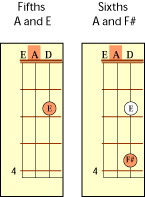

The Easiest Way To Master The Fretboard!
The series was developed visually, because people natively think visually. You do not have to interpret a picture. You can understand it by looking at it.
And when you combine it with knowledgable text, the meaning and rules of music will jump out at you!
Immediately you will begin to see into the instrument and develop an understanding that is not possible any other way.
This is one of the main reasons this series of books carry a lifetime guarantee. We back up our words with an iron clad policy that has been in place for years!
eBooks are delivered instantly!
By Tim Gillespie
If you have not played this type of progression before, there are two things that strike me as the basics.
1. You must be able to play the simple chords in this progression.
2. You must be able to transition in and out of the fifths.
The first thing you must do here is get to know the chords. So start by playing the progression slowly. Work back and forth through the chords and concentrate on linking them. If there are strings that are buzzing or some glitches that are stopping you from hitting the chord correctly, then identify the areas and make up some exercises that reinforce the right way to move to the chord. Be smart about this and you will remove those problem areas.
Playing the fifths is a little harder than just strumming a chord as you strum every string. Playing the fifths is usually limited to just two strings. And the fretboard hand has a constant motion to it to produce the signature effect of this sound.
E Fifth
 I
have removed everything except the exact area this fifth is played in.
The B note is shown white in the second example because you are still
holding the note down, even though you are not playing it. You do this
because in a moment you will lift your finger off the C# note and let
the B note sound. Use your index finger to hold down the B note and your
third finger to play the C# note. This sound file is four bars long.
I
have removed everything except the exact area this fifth is played in.
The B note is shown white in the second example because you are still
holding the note down, even though you are not playing it. You do this
because in a moment you will lift your finger off the C# note and let
the B note sound. Use your index finger to hold down the B note and your
third finger to play the C# note. This sound file is four bars long.
![]() Remember
you are playing a fifth (the distance between E and B) and a sixth, (the
distance between E and C#). Consult the scale of E major (or A major)
if you are having a problem with this.
Remember
you are playing a fifth (the distance between E and B) and a sixth, (the
distance between E and C#). Consult the scale of E major (or A major)
if you are having a problem with this.
O, yea. Don't hit any other strings as you are doing this. Work with only these two notes. The reason I chose this exact chord as an example is this is the easiest fifth to play on the entire fretboard. The A fifth is slightly harder.
A Fifth
 Same
thing with this fifth only now you cannot hit the low E string. You have
to skip over it without sounding it and play the A note and the E / F#
notes. Use your index finger to hold down the E note and your third finger
to play the F# note. You can use others, but these work nicely.
Same
thing with this fifth only now you cannot hit the low E string. You have
to skip over it without sounding it and play the A note and the E / F#
notes. Use your index finger to hold down the E note and your third finger
to play the F# note. You can use others, but these work nicely.
![]() This
is a more exacting move if you are using a pick because the pick cannot
hit the low E string. Of course it will the first several times you play
this, but this exercise should serve to help you develop the exact location
of the sweep path.
This
is a more exacting move if you are using a pick because the pick cannot
hit the low E string. Of course it will the first several times you play
this, but this exercise should serve to help you develop the exact location
of the sweep path.
Once you develop the feel of this, the rest is just timing and working on playing smoothly. This sound file is two bars long.
E Major Scale

 This
is one of my favorite scales. I would suggest you play this one often
particularly if you are new to scales. It is a great builder of strength
and lots of fun. This is the scale I would use to construct leads from.
Every time I build one, I climb out of the scale and use the registers
above it.
This
is one of my favorite scales. I would suggest you play this one often
particularly if you are new to scales. It is a great builder of strength
and lots of fun. This is the scale I would use to construct leads from.
Every time I build one, I climb out of the scale and use the registers
above it.
Remember to play all the notes according to the finger chart. This scale is much easier to play if you use the right fingers.